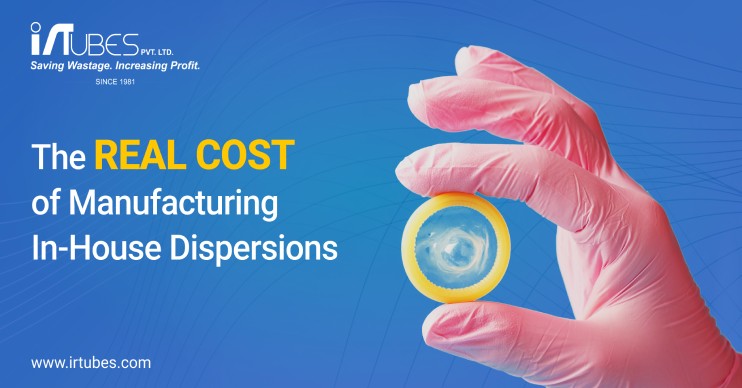
A simplistic comparison of only the raw material cost would normally lead one to believe that in-house manufacture is cheaper than buying readymade water-based dispersions. However, to make a fair comparison, the dispersions user MUST consider the real costs of in-house dispersion manufacture which include many other items & factors as listed below
- Non-active ingredients cost
- Capital cost of plant & equipment for dispersion manufacture
- Cost of Maintenance & up-keep of plant & equipment including keeping an inventory of essential spare parts
- Capital and running costs of laboratory & laboratory equipment required to control the quality of in-house dispersions
- Cost of keeping and controlling raw materials inventories for multiple materials (outsourced dispersion can be a ‘composite’ containing several ingredients) including staff costs, factory space & financial outlay.
- Cost of the factory space utilized for the in-house dispersion making activities. This is not only the actual cost of rental / purchase but an additional ‘opportunity cost’ if the space can be more profitably used for production of the mainline product (e.g. gloves)
- Cost of the labour / staff to carry out and control the production and QC
- Cost of energy (usually electricity) for the mix preparation, milling & packaging operations.
- Costs of treating effluent and disposing of wastes arising from dispersion manufacture
- Cost of raw materials packaging waste (may require disposal in same category as chemical wastes)
- Cost of potential downtime on mainline production which is replying on the in- house dispersion
- Cost of wasted or down-graded final product if the quality consistency of the in- house dispersion is not maintained
- Compared to a specialized dispersion manufacturer, the user making in-house will have a smaller scale of operation which will result in
- Bigger impact from fixed and capital costs
- Higher percentage of materials wasted
- Lower purchasing power on raw materials
- Costs of regulatory compliance per tonne of dispersion will be more
- Labour / staff cost per tonne of dispersion will be higher
When all the additional real cost factors associated with in-house dispersion manufacture are considered by the dispersion user, it becomes easier to see why many dispersion users are prepared to pay an increased raw material cost for buying readymade water-based dispersions.
But how much is the increased cost? What if with a price increase of Rs.0.02 paise you could be assured of a high-quality dispersion?
We, at I. R. Tubes Pvt. Ltd. did a calculation of our own based upon a standard formulation and give below what the cost will be with chemicals bought at MARKET prices and what the cost would be if you went for OUR chemicals.
Table 1:
| COSTING AT MARKET PRICES | |||
| Ingredients | Qty. (Kgs) | Cost (Rs.) | Total Cost (Rs.) |
| 60% NR Latex | 167.00 | 95.00 | 15,865.00 |
| 60% Sulphur | 1.50 | 24.00 | 36.00 |
| 50% ZnO | 0.50 | 125.00 | 62.50 |
| 50% ZDBC | 1.00 | 187.50 | 187.50 |
| 50% ZMBT | 1.00 | 197.50 | 197.50 |
| 50% Anti-Oxidant | 1.00 | 250.00 | 250.00 |
| 172.00 | 16,598.50 | ||
| Per Kg. Cost | 96.50 |
Table 2:
| COSTING USING CHEMICALS FROM I.R. TUBES. | |||
| Ingredients | Qty. (Kgs) | Cost (Rs.) | Total Cost (Rs.) |
| 60% NR Latex | 167.00 | 95.00 | 15,865.00 |
| 60% Sulphur | 1.50 | 135.00 | 202.50 |
| 50% ZnO | 0.50 | 475.00 | 237.50 |
| 50% ZDBC | 1.00 | 350.00 | 350.00 |
| 50% ZMBT | 1.00 | 390.00 | 390.00 |
| 50% Anti-Oxidant | 1.00 | 475.00 | 475.00 |
| 172.00 | 17,520.00 | ||
| Per Kg. Cost | 101.860 |
Our observations
- The difference between both costings has a minimal difference of Rs. 5.36 (Rs. 101.86 – Rs.96.50) per kg
- Calculating the price difference per piece of a female condom whilst taking the weight at 3 grams, the increase in price would be Rs.0.02 paise
- This is a ‘current cost’ basis of comparison which if considered in full can be enough to make an outsourcing decision attractive.
CONCLUSION
After taking all the above-mentioned factors into consideration, it continues to be abundantly clear why paying some reasonable raw material cost increase for outsourced dispersions makes extremely good business sense.
All our products are RoHS and REACH Compliant, which have always met with great customer satisfaction. We offer great service at a very competitive price and have never been known to compromise on the quality of our products. We cater to flexible quantities as per your requirement.
I R Tubes Private Ltd., Pune are distributors for quality chemicals of Deutsche Oelfabrik of Germany, Robinson Brothers, UK, Emery Oleochemicals Ltd and Aquaspersions. Our chemicals are used in the manufacture of Rubber, Plastics, Latex, Adhesives and Sealants.
